This project begins, not with Mars, but with New Mexico. While I was in graduate school, I traveled to Deming, a small town in southern New Mexico. Outside of town was a failed development, the Deming Ranchettes. The development was never meant to succeed. Realtors sold off plots of land – cheap desert land – to people living far away on the East Coast. They advertised the health and psychological benefits of living in a sunnier region of the country, but they didn’t actually intend for people to live there. No infrastructure exists on the site – no electricity, no roads, and certainly no water. The water rights in that region of the country were already owned by other people, so the development was truly an impossibility. It also is not particularly picturesque. On one side of the planned subdivision is a rail line and on the other side is I-10. But there is no highway access at the site – you must drive to another town and follow a dirt cattle road. But people bought the land. Occasionally, a brave individual made the trek to Deming to find his or her plot, only to realize how remote and inaccessible the land really is. While the developers didn’t expect many people to visit the site in person, they allowed people to dream of a better life somewhere else. Simply by owning land in a place that seemed better/more exotic/more exciting than the current situation, they became a bit like adventurers. It was a first step toward a bigger change, a potential new beginning. Explorers claim land, and even if the owners of the Deming Ranchettes have never actually set foot in the desert, they now own a piece of it, and they could perhaps/maybe/someday live there. They are adventurous land purchasers.
I decided to delve into the NASA image archive of the planet Mars. These pictures from the Mars orbiters and rovers form the basis of the exhibition – their visual similarity to terrestrial deserts is striking.
This body of work transplants the pieces of a traditional suburban existence onto the alien surface of Mars. The prints seem to promise that, when you do decide to make the big move, nothing will be all that different – you will still have your cookie cutter home, your fancy hairdo, your satellite garden, and your tank of a vehicle. Life continues as normal, just under a somewhat redder sky.
The smaller screenprinted figures sport the Sputnik-chic design aesthetics of the 1950s and 1960s in bright poster colors, while the shiny copper background cracks and crumbles around them. Certainly Mars is not terrestrial, and the presence of an unnatural sky reiterates this unearthly setting. And while we on Earth see Mars shining high in the sky, regrettably, Mars still remains not quite Heaven, so the copper leaf simply establishes an otherworldly environment with a somewhat reddish hue.
The small circles sprinkled over the larger screenprints of houses and the mountain covered in flags suggest the tiny particles that comprise all matter. Even as the screenprinted elements offer a picture of bold solidity, the drawn circles spilling over the composition suggest the entropic movement of energy and the ultimate decomposition and crumbling of everything into dust.
There is something extraordinarily captivating about the unknown. The planet Mars was a pristine otherworldly mystery not long ago, but our presence there, even via rovers, takes away a good bit of the magic. Our quest for knowledge leads us to explore and document greater swathes of the planet leaving less and less up to the imagination. There seems to be no alien life, certainly nothing along the lines of War of the Worlds – Mars may indeed be a chunk of dead rock spinning alone in space. It is interesting, though, that in order to prove that alien life does not exist on the red planet, life alien to it had to make its own fresh tracks in the sand.
When I think about living on Mars, the idea captures the allure of the frontier – of looking out for miles and of seeing nothing but undisturbed landscape. There are few places like this on Earth, where one can feel completely alone. The prints that exemplify this idea the best show a single figure on the planet – as if he or she owns the whole rusty world. It is both a triumphant accomplishment and a profoundly isolating one. In reality, many people would aspire to live on Mars, and while they would not possess the means to build their dream homes on the neighboring planet, the landscape itself would be surveyed and marked. People would stake their claims, and, regardless of whether or not houses actually materialized, the landscape would change. Instead of the tantalizing mystery of an uninhabited world, Mars’s surface would become a neat grid of tidy lines.
This fantastical colonization of the planet Mars begins with a housing development called Sanguine Estates. The name evokes the cheerful promises of a new beginning, along with the color red (for the red planet). Sanguine refers to blood, hence, red-colored, flushed, and full of life. But calling a development bloody suggests something a bit negative. During the construction of housing developments, and certainly throughout the colonization of new frontiers, there is always a bit of blood. Maybe bad blood between those who were there before and the new arrivals; maybe new blood as an aging community is rejuvenated; certainly bloodshed if there is resistance. Sanguine Estates captures these diverse meanings of the word, promising a future full of life, but also suggesting the price we pay for progress. Our nation’s history of westward expansion and immigration pushes us toward a future of off-world settlement, with the nearest planet presenting an almost plausible substitute for the formerly Wild West. In the spirit of Gordon Matta-Clark’s Fake Estates, I propose an agenda promoting a familiar yet futuristic living experience on our neighboring planet. By merging the comfort of suburban tract housing with the foreign Martian terrain, this fantastical colonization of the planet Mars guarantees all residents a rosy existence away from the mundane distractions of life on Earth. Are you ready to move to Mars?
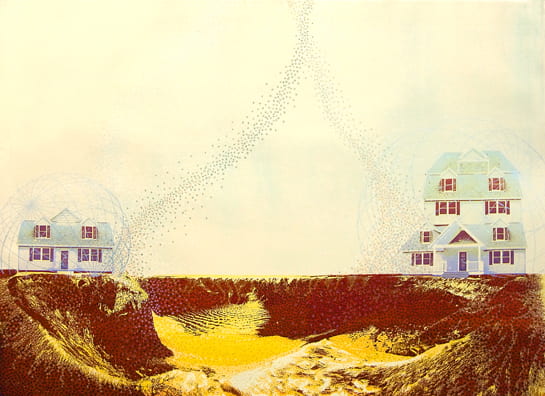 Crater Neighbors
Crater Neighbors
2010, screenprint, color pencil, 22 x 30 inches
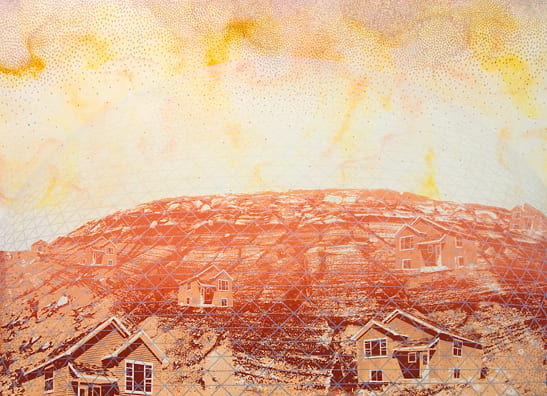 Suburban Dome
Suburban Dome
2010, screenprint, color pencil, 22 x 30 inches
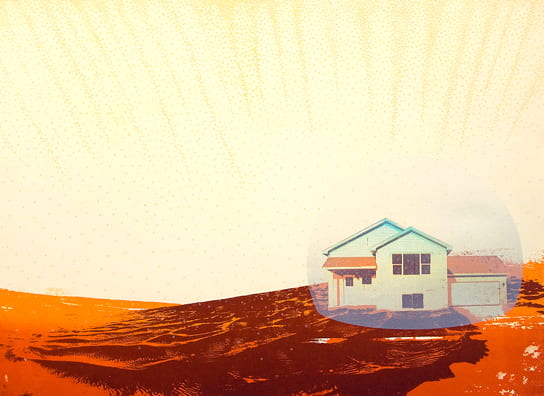 Bubble House
Bubble House
2010, screenprint, color pencil, 22 x 30 inches
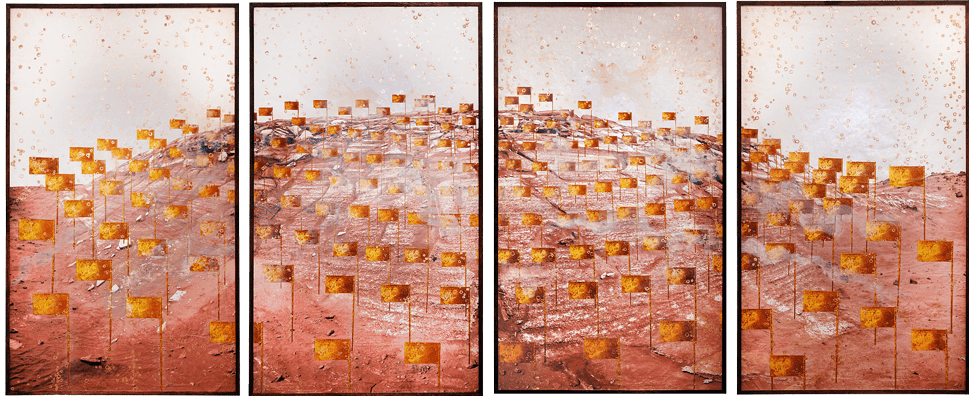 Big Mountain
Big Mountain
2010, archival pigment print, screenprint, stencil, copper leaf, four panels, each 72 x 42 inches
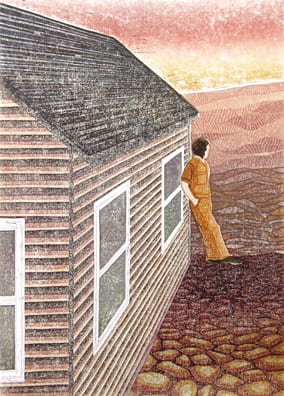 Home on the Basaltic Plains
Home on the Basaltic Plains
2011, woodcut, 22 x 15 inches
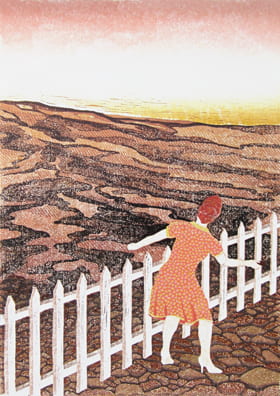 Skipping Stones on the Lava Flows of Olympus Mons
Skipping Stones on the Lava Flows of Olympus Mons
2011, woodcut, 22 x 15 inches
 Red Light at the Edge of the Caldera
Red Light at the Edge of the Caldera
2011, woodcut, 22 x 15 inches
 Traffic over Tharsis
Traffic over Tharsis
2011, woodcut, 22 x 15 inches
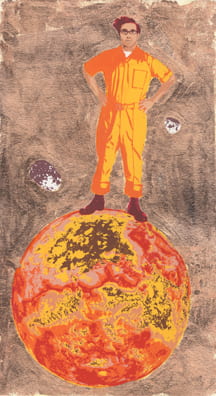 Super Mars
Super Mars
2010, screenprint, copper leaf, 11 x 5.5 inches
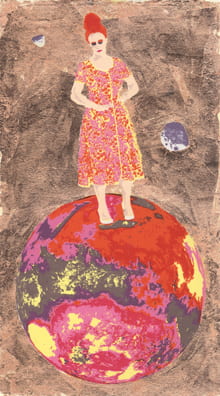 Beehive Mars
Beehive Mars
2010, screenprint, copper leaf, 11 x 5.5 inches
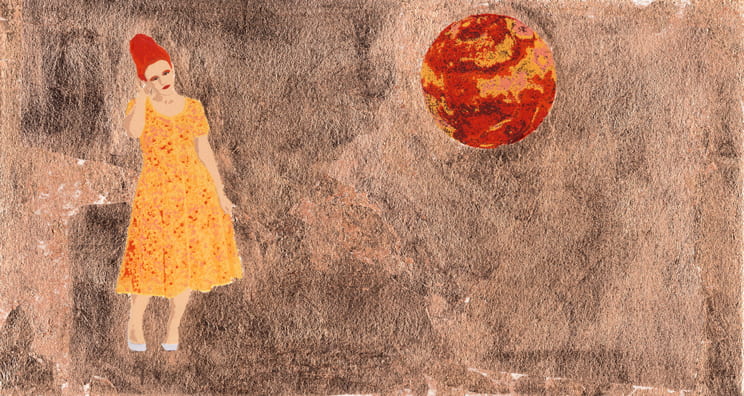 Dreaming Mars
Dreaming Mars
2010, screenprint, copper leaf, 5.5 x 11 inches
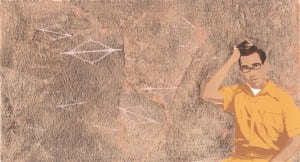 Uh-Oh UFO
Uh-Oh UFO
2010, screenprint, copper leaf, 5.5 x 11 inches
 Fort Houses
Fort Houses
2010, screenprint, copper leaf, 11 x 5.5 inches
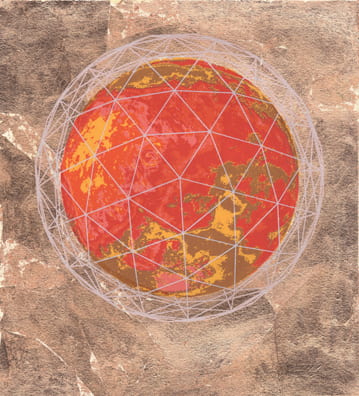 Planet Mars
Planet Mars
2010, screenprint, copper leaf, 11 x 10 inches
Everyone Wants to Live on Mars
Stop-motion animation produced in collaboration with Joseph Mougel
The Listening Garden
Stop-motion animation produced in collaboration with Joseph Mougel